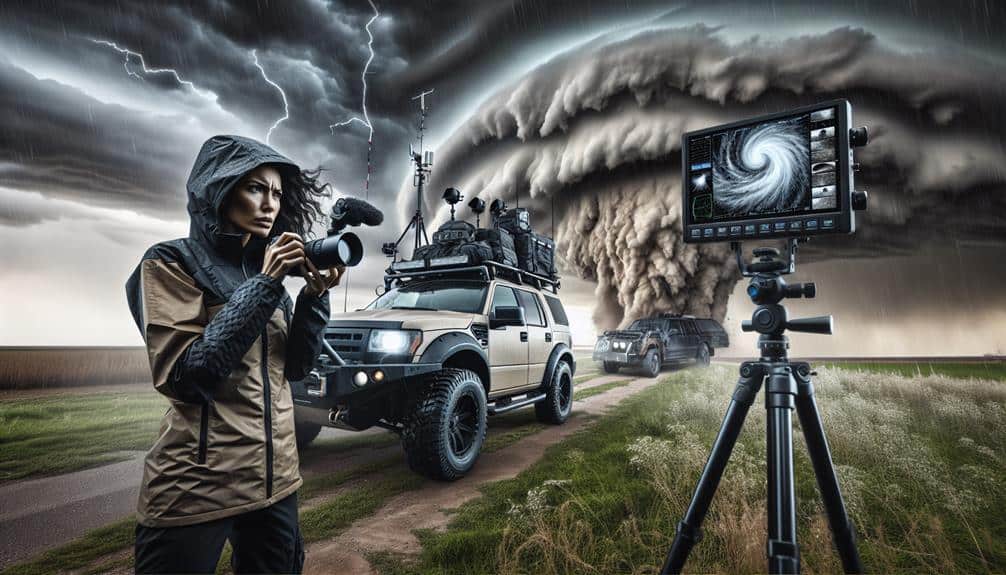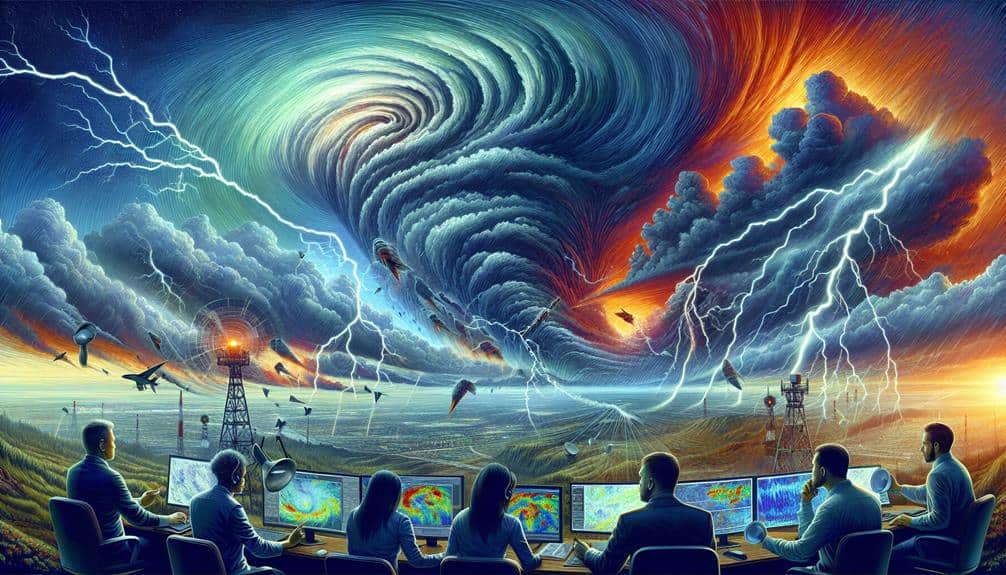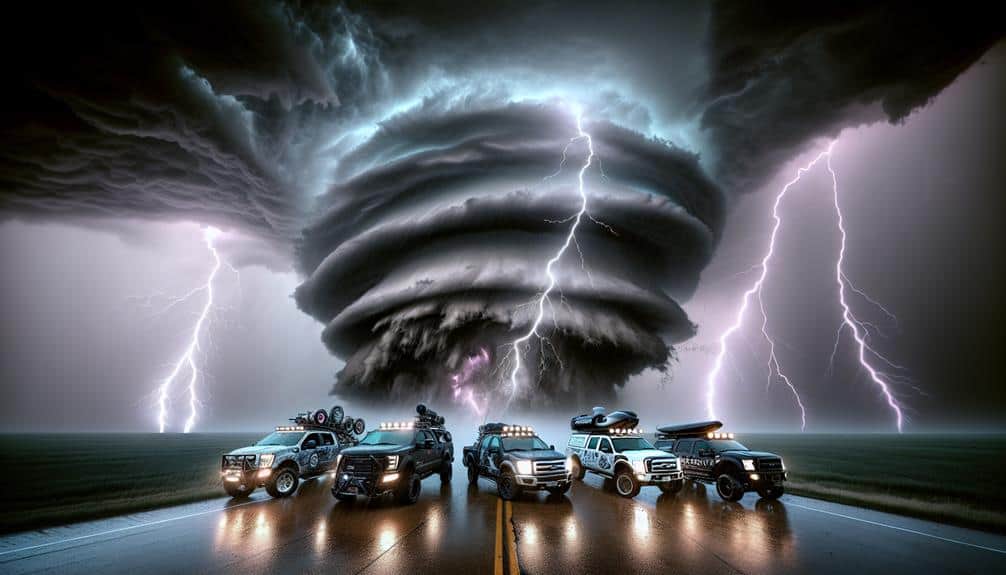Chasing supercells is an exhilarating adventure that combines scientific pursuit with raw natural power. We analyze wind shear, moisture, instability, and lift to predict where these rotating storms will form. Using Doppler radar, satellite imagery, and real-time weather apps, we maneuver through unpredictable terrain to capture extreme weather phenomena like tornadoes and large hail. Our high-definition cameras and drones document the storm's intensity while GPS guarantees our safety. The dynamic atmosphere demands constant data analysis and split-second decision-making, making each chase a unique test of our skills and equipment. To uncover what makes this experience so compelling, let's journey further into the science and thrill of storm chasing.
Key Points
- The thrill of navigating unpredictable and rapidly changing weather conditions adds to the excitement.
- Capturing stunning footage of nature's most powerful storms offers a unique and exhilarating experience.
- Real-time data analysis and decision-making create a dynamic and engaging pursuit.
- The potential to witness extreme weather phenomena, like tornadoes and large hail, provides an adrenaline rush.
Witnessing Nature's Fury
In the late spring months, we often find ourselves tracking the formation of supercells with a mix of anticipation and trepidation. As storm chasers, our primary goal is to witness nature's fury up close while ensuring safety.
Supercells, characterized by their rotating updrafts, are the most critical type of thunderstorms, often leading to extreme weather phenomena like tornadoes, large hail, and flash floods.
We rely heavily on data from Doppler radar, satellite imagery, and atmospheric soundings to predict and locate these intense storms. Meteorological models help us analyze parameters such as wind shear, moisture, and instability, which are essential for supercell development. By monitoring these variables, we can pinpoint areas with the highest potential for extreme weather.
Our commitment to capturing these powerful displays isn't just about the thrill; it's about advancing scientific understanding. Every storm we document adds valuable data to the meteorological community, helping improve future forecasts and warning systems.
As we chase these storms, we're not only driven by the desire for freedom but also by the quest for knowledge, always balancing the awe of nature's power with respect for its unpredictability.
Adrenaline-Pumping Pursuit
As we pinpoint areas with the highest potential for extreme weather, the rush of adrenaline kicks in, fueling our pursuit of these formidable supercells. We rely on cutting-edge meteorological data and advanced forecasting models to identify prime storm-chasing locations. The blend of scientific precision and raw excitement is what makes this adventure truly exhilarating.
In our extreme chasing endeavors, we balance the thrill of the chase with the need for safety and accuracy. We use high-resolution radar, satellite imagery, and real-time weather updates to track storm movements and intensities. This meticulous approach guarantees we're always a step ahead, prepared to capture the perfect moment.
- Advanced Doppler radar: Helps us track wind speeds and storm structures with precision.
- Satellite imagery: Provides a broader view of the storm's development and trajectory.
- GPS navigation systems: Assures we navigate safely through unpredictable terrain.
- Real-time weather apps: Keeps us updated on storm warnings and alerts.
Our commitment to data-driven decisions not only enhances our extreme chasing experience but also hones our storm photography skills. This calculated yet thrilling pursuit embodies the freedom and exhilaration we seek in nature's most dramatic displays.
Capturing Stunning Footage
Harnessing our high-definition cameras and specialized lenses, we're able to capture the breathtaking dynamics of supercells in mesmerizing detail. The precision of our equipment allows us to document these powerful storms with unmatched clarity.
By utilizing drone perspectives, we gain a vantage point that ground-based storm chasing simply can't offer. Drones provide an aerial view, capturing cinematic shots that reveal the intricate structures and rotations within the storm.
Our data-driven approach ensures that every frame we capture holds significant scientific value. High-speed imaging allows us to freeze lightning strikes and record the rapid development of storm cells. This footage isn't just visually enthralling; it offers insights into the behavior and progression of supercells.
Advanced stabilization technology in our drones ensures that even in turbulent conditions, our shots remain sharp and steady.
In storm chasing, timing is everything. We use real-time weather data to position ourselves strategically, guaranteeing we capture the most dramatic moments. This combination of advanced technology and strategic planning allows us to film supercells in ways that were unimaginable just a decade ago.
Our footage doesn't just document storms; it immortalizes the raw power and beauty of nature's most formidable phenomena.
Understanding Supercell Dynamics
Understanding the complex dynamics of supercells requires a detailed analysis of various atmospheric parameters and their interactions. As storm chasers, we explore the intricacies of storm formation, examining how specific atmospheric conditions contribute to the creation and evolution of these powerful weather phenomena. By assessing factors such as wind shear, moisture, instability, and lift, we gain insights into the mechanisms propelling supercell development.
We can't ignore the significance of safety protocols in our pursuit. Balancing the excitement of storm chasing with a commitment to safety guarantees we can continue to study these meteorological wonders without unnecessary risk.
Here are some key elements we consider:
- Wind Shear: The variation in wind speed and direction with altitude, essential for supercell formation.
- Moisture: The presence of humid air, which sustains storm development.
- Instability: The propensity for air parcels to ascend, generating the updrafts essential for supercells.
- Lift: Mechanisms like frontal boundaries that push air upwards.
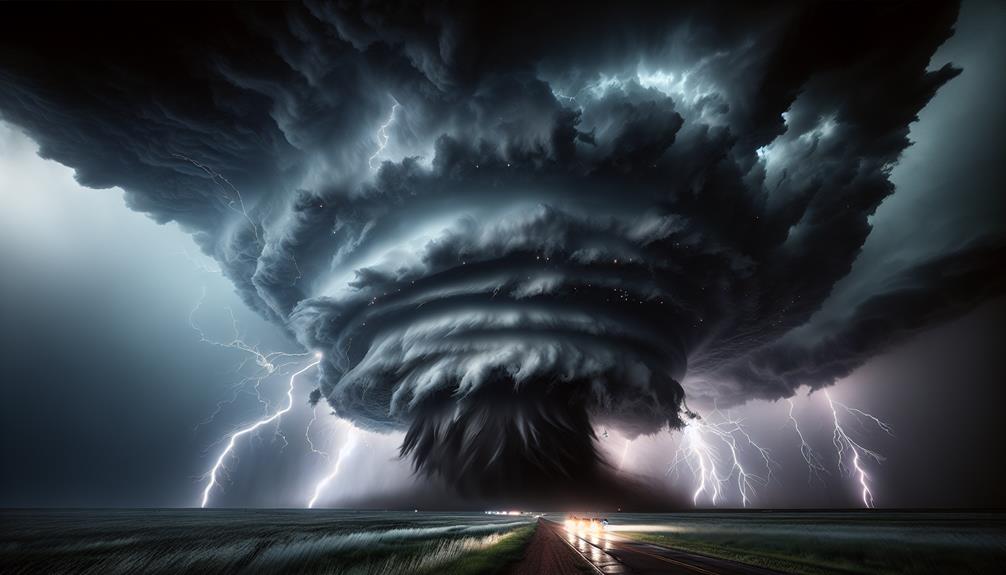
Dealing with extreme weather demands we utilize real-time data and predictive models to make informed decisions while in the field. In storm chasing, our ability to interpret weather forecasting data is essential. We rely on high-resolution radar imagery, satellite feeds, and ground-based observations to track supercell development. By analyzing these data streams, we can predict storm paths, intensity, and potential hazards with greater accuracy.
We use tools like Doppler radar to observe wind patterns and rotation within thunderstorms, which helps us identify mesocyclones and potential tornado formation. Numerical weather prediction models provide forecasts that are invaluable in evaluating the likelihood of supercell formation. These models simulate atmospheric conditions by solving complex mathematical equations, offering a probabilistic outlook on storm behavior.
Our vehicles are equipped with mobile weather stations, enabling us to measure temperature, humidity, and wind speed in real-time. This field data, combined with remote sensing information, enhances our situational awareness. Advanced GPS systems allow us to navigate safely through treacherous conditions, avoiding hail cores and flash floods.
In the exhilarating pursuit of storm chasing, our freedom hinges on precise, data-driven decision-making. By mastering weather forecasting technologies, we can navigate extreme weather with confidence and safety.
Building Camaraderie
Building camaraderie among storm chasers is vital for effective teamwork and guaranteeing everyone's safety in the field. When we chase supercells, our shared passion for meteorology and extreme weather forms the foundation of our team dynamics. This bond isn't just about enjoying the excitement; it's about creating a unified unit that can react promptly and proficiently to changing conditions.
Strong team dynamics are essential when we face the unpredictable nature of supercells. Trust and communication are fundamental elements. We depend on each other's expertise and judgment, which improves our ability to make data-driven decisions rapidly. Through these experiences, we cultivate lasting friendships that go beyond the chase.
To foster bonding and enhance our operational efficiency, we prioritize:
- Regular team meetings to discuss strategies and share insights.
- Training sessions to make certain everyone is up-to-date with the latest technology and safety protocols.
- Post-chase debriefs to evaluate our performance and learn from each chase.
- Social activities outside of storm chasing to strengthen personal connections.
In essence, our shared passion brings us together, and our dedication to each other makes us a formidable team in the face of nature's fury.
Experiencing Unpredictability
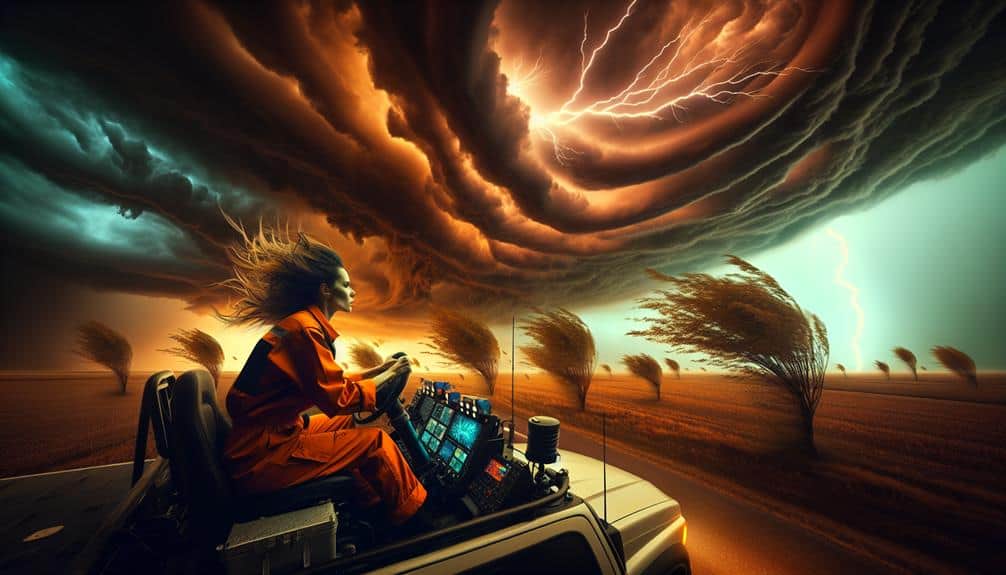
Every storm chase presents a unique set of challenges and variables that test our preparedness and adaptability in the face of nature's unpredictability. The dynamic atmosphere can shift rapidly, requiring us to constantly analyze real-time data from radar, satellite imagery, and weather models. This constant vigilance is an essential part of embracing chaos and embracing thrill.
When we pursue supercells, we encounter both unpredictable beauty and unpredictable danger. The formation of a supercell is a complex process influenced by numerous factors, including wind shear, humidity, and temperature gradients. These variables create an environment where conditions can change in an instant.
One moment, we might be mesmerized by the majestic structure of a rotating updraft; the next, we could be repositioning to avoid a rapidly developing tornado. Our chase vehicles are equipped with advanced meteorological instruments that provide us with the data needed to make split-second decisions. However, even the most sophisticated technology can't eliminate the inherent uncertainty of storm chasing.
This unpredictability is what makes each chase an adventure, a test of our skills, and a tribute to our desire for freedom. The thrill lies in maneuvering this balance between awe-inspiring natural phenomena and the very real dangers they present.
Frequently Asked Questions
What Safety Gear Is Essential for Chasing Supercells?
We prioritize safety equipment, including helmets and reinforced vehicles. Reliable communication devices keep us connected. We establish emergency plans and identify storm shelters beforehand to guarantee we can quickly respond to changing conditions and protect ourselves effectively.
How Do You Prepare Mentally for a Supercell Chase?
We focus on mental preparation by incorporating stress management strategies. We use visualization techniques and mindfulness practice to anticipate scenarios, ensuring we stay calm and analytical. This approach maximizes our decision-making freedom during a supercell chase.
What Are the Most Common Risks Involved in Supercell Chasing?
We grasp the appeal of freedom in storm chasing. The most common risks are severe weather conditions and driving risks. We mitigate these with safety measures, but visibility challenges remain, necessitating constant vigilance and analytical decision-making.
How Do You Finance a Supercell Chasing Expedition?
We finance our supercell chasing expeditions by implementing rigorous budgeting strategies and seeking sponsorship opportunities. Analyzing costs and securing sponsors guarantees we maximize our resources while maintaining the freedom to pursue this thrilling scientific endeavor.
Can Beginners Join Experienced Supercell Chasers on Their Adventures?
Beginner participation in supercell chasing under experienced guidance offers invaluable learning opportunities. Team dynamics enhance the experience, ensuring safety and skill-building. Data shows beginners quickly adapt, benefiting from seasoned chasers' expertise, making it an ideal collaborative adventure.
